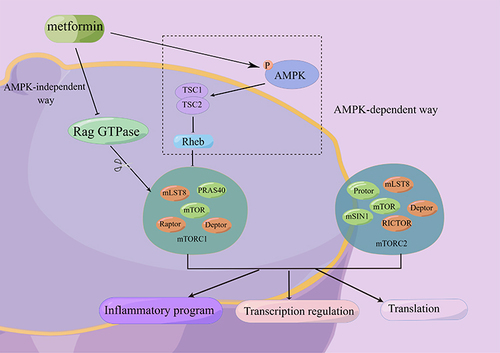Figures & data
Figure 1 Metformin inhibits mTOR both with and without activating AMPK. There are two ways that metformin could inhibit mTORC1 downstream: (1) After AMPK activity is activated, the TSC1/TSC2 complex (which can inhibit the activity of Rheb) is activated, and then the action of mTORC1 activity is inhibited. (2) Metformin inhibited Rag GTPase activity in an AMPK-independent manner, thereby inhibiting mTORC1. mTOR has two complexes, mTORC1 and mTORC2, which have important regulatory effects on inflammation, gene transcription, protein translation, etc.

Table 1 Effects of Metformin Targeting mTOR on Inflammatory Diseases
Figure 2 Metformin reduces inflammation by regulating the autophagy process. TLR family members activated by PAMPs or DAMPs initiate the innate immune response as a response to infection or injury. Then, it activates NF-kB and further activates the NLRP3 inflammasome. Upon NLRP3 activation, pro-IL1-β and pro-IL18 were cleaved into mature and active IL1-β and IL18. These cytokines are subsequently released, initiating an inflammatory response. Metformin activates AMPK, inhibits mTOR, and activates the ULK complex, thus inducing autophagy and further blocking the activation of NLRP3, inhibiting inflammation. Autophagy involves the formation of autophagosomes, fusion of autophagosomes with lysosomes, and degradation of the autophagy-lysosomes. Metformin could also scavenge mtDNA and mtROS through mitophagy induction via the inhibition of mitochondrial complex I, inhibiting NLRP3 inflammasome activation, thus eventually inhibiting inflammation.

